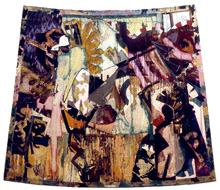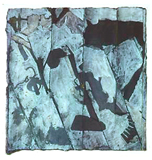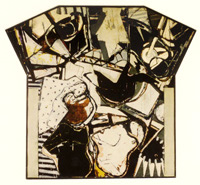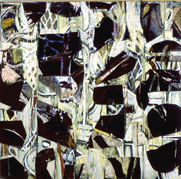text: nicholas alfrey
paintings & collages
october 1985
The works in this exhibition have all involved the process of collage in their making. The paintings have reached their definitive form only after successive phases of obliteration and recovery. Once a work has begun, a canvas may be divided into strips, the sections moved out of alignment or spliced into a different compositon altogether. In this way an initial configuration is soon lost to sight as forms are cut into, folded back, repeated or cancelled. A rhythmic pattern of disruptions is gradually established, in which fragments and traces of earlier stages are contained within a regenerated order. |
|
The imagery in these paintings is fragmented and therefore disclosed obliquely, and relates to landscape, interiors and architectural forms. Each piece carries associations of a particular place or experience, and the group of paintings as a whole might be understood as constituting a kind of pictorial diary or autobiography.The paintings are developed as a series of contrasts and oppositions: a tall light-filled bay window is followed by an attic fill of looming, shrouded forms, neon-lit streets by open air, birchwood and rockface. In complete contrast, the two most recent paintings have an ornate old-Europe quality. |
 |
 |
The physicality of the work is emphasised at every stage, through the weather-beaten surfaces, the insistent piecing and cutting of the collage process and the imposing scale. The shape of the field is sometimes opened out as if to enclose the spectator; elsewhere the sides are slanted making the picture plane appear to fan outwards or to slope steeply away. Strong tonal contrasts contribute to a sense of drama: blacks stamped out against flurries of silver, serrated darks sheared by light. The most recent painting, however, Bishop's Dream, a work still in progress, displays a growing concern for richness and transparency of colour and intricacy of detail. |
The large paintings exhibited here span a period of five years; individual works evolve slowly, usually taking several months to complete, but the group as a whole is strikingly unified in character. Christopher Jones has remained consistent in his way of working, and has been systematic in his exploration of the possibilities such a method raises. His points of departure have remained no less constant: Braque's studio interiors, for example, and more especially the early work of de Kooning have evidently been a continuing source of inspiration. These may be unfashionable influences, but this in itself is only a further indicaton of an independence of judgement. He is an artist who has an unusually clear idea of what can still be achieved. |
|
 |
 |